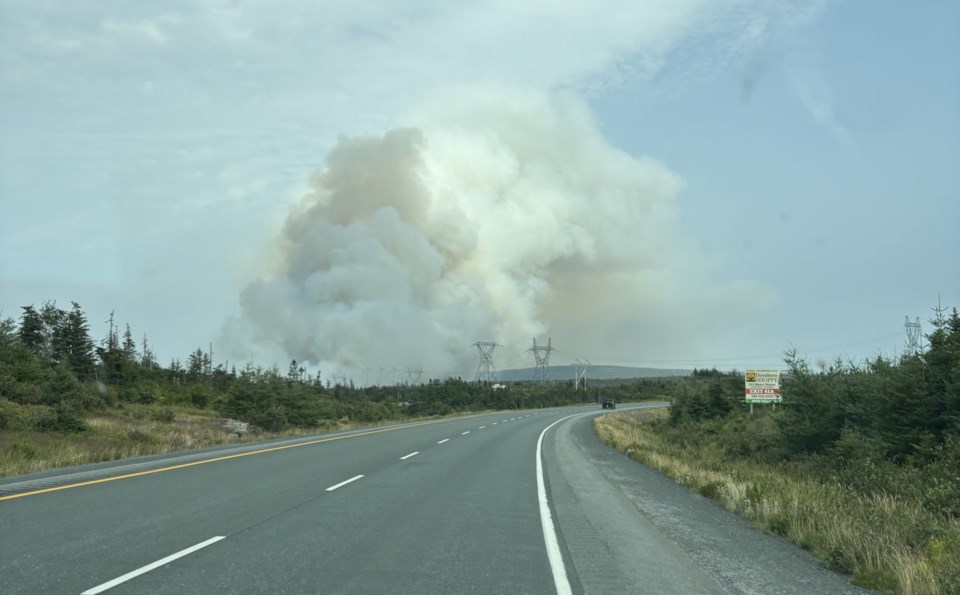ST. JOHN'S — About 20,000 people living on the outskirts of St. John's, N.L., were preparing to evacuate their homes and businesses Tuesday as a new wildfire burned near the province's largest city.
Premier John Hogan issued a precautionary evacuation alert late Monday for parts of two towns southwest of St. John's — Paradise and Conception Bay South. New alerts were issued Tuesday for Galway and Southlands, neighbourhoods on the western edge of the port city.
Sharlene Johnson, a single mother living in Conception Bay South, said she could see the fire from her home.
“I’m kind of just a sitting duck right now, waiting to see and reading news updates,” she said in an interview Tuesday.
Johnson and her two children live close to a wooded area. To prepare for an evacuation, they sprayed their home with water. They also took pictures of the property in case they need to file an insurance claim.
“I do worry about things like if I have to leave here or if my home was to burn down. It’s something that is now very real to me and it’s terrifying," she said.
In the early morning hours, photos shared on social media showed long lineups at some local gas stations.
“It was like the onset of COVID, where everybody was rushing to get essentials and toiletries,” Johnson said. “It was like mass chaos. I think that amped up the panic as well.”
The new wildfire erupted Monday near Paddy’s Pond, about 15 kilometres south of downtown St. John’s. The fire quickly grew to about two square kilometres and four water bombers were dispatched to douse the flames.
Provincial officials said the Paddy's Pond fire was burning near electricity transmission lines maintained by Newfoundland and Labrador Hydro. They said one line was affected by the flames but no power outages were reported.
As of Tuesday morning, five of the province's active wildfires were considered out of control — three in Newfoundland and two in Labrador.
A fire that started just over a week ago near Kingston, N.L., on the northwestern shore of Conception Bay, is by far the largest at 52 square kilometres. As of Saturday, the flames had forced about 3,000 people in the area from their homes.
Hogan has said officials don't know how many homes or other buildings have been destroyed by the fire because the smoke has been too thick to get an accurate tally.
In New Brunswick, two out-of-control wildfires were burning Tuesday, with residents north of Moncton told to prepare for evacuation.
The province's wildfire dashboard map shows that an out-of-control wildfire reported Monday south of Bathurst had been contained by Tuesday morning.
Despite parched conditions in much of New Brunswick, there have been no evacuations and no homes or other structures have been lost.
Still, 14 air tankers and three helicopters are part of the firefighting effort. As well, five firefighters from P.E.I. and five from Maine have arrived to help. Another 20 firefighters were expected to arrive Wednesday from Nova Scotia.
The out-of-control wildfire north of Miramichi had grown to 11 square kilometres by Tuesday, and the one near Irishtown, north of Moncton, had burned less than a square kilometre.
Meanwhile, Environment Canada confirmed that almost every corner of the Maritimes suffered from a lack of rainfall in June and July.
The department produced a precipitation anomaly map showing dry conditions were particularly pronounced in northeastern and southern New Brunswick, especially around Saint John. As well, a large area surrounding Halifax has seen very little rain. In those three areas, the two-month rainfall total was between 100 and 120 millimetres less than average.
Agriculture Canada released a drought assessment Tuesday that shows 56 per cent of Atlantic Canada is classified as abnormally dry, with 90 per cent of Nova Scotia in a moderate drought.
The statistics also show that St John’s has received only a third of the rain it usually gets between April and July. In Halifax, the figure is about 40 per cent.
This report by The Canadian Press was first published Aug. 12, 2025.
— By Michael MacDonald in Halifax, with files from Sarah Smellie in St. John's, N.L., and Keith Doucette in Halifax.
The Canadian Press


